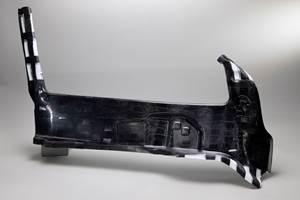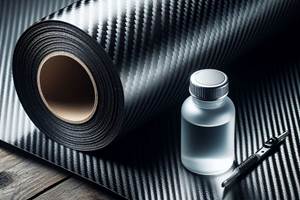NAIA Show Highlights
The 2007 Detroit Auto Show emphasizes “green” themes and high performance.
The 2008 North American International Auto Show, held Jan. 19-27 at the Cobo Conference/Exhibition Center in Detroit, Mich., once again served as the leading showcase for production and concept vehicle introductions from domestic and international OEMs. In response to market realities — persistently high oil prices and escalating Corporate Average Fuel Economy (CAFE) standards — most exhibiting automakers had at least one vehicle on display with a hybrid power train or other high-mileage concept.
In 2007, General Motors’ Volt plug-in hybrid concept was well received, and GM plans to market the vehicle in 2010. The hybrid concept is attracting new players to the automotive market. Startup Fiskers Automotive (Lake Forest, Calif.) unveiled the 2010 model Karma plug-in four-door hybrid, which is capable of running 50 miles on a single overnight charge of its lithium-ion batteries and more than 600 miles when its small gasoline engine powers an onboard generator. Priced at around $80,000 (USD), the Karma is slated for production in late 2009 at volumes of approximately 20,000 per year. What components will be composite is as yet unannounced.
In conjunction with the event, the Automotive Composites Alliance (ACA) held a day long reception at a venue adjacent to Cobo Hall, featuring composite components and the chance to learn more about the materials and methods used to produce them. Addressing head-on the fact that today’s hybrid vehicles do not employ any sizable composite content, the ACA presented results of a benchmarking study in which a prototype hybrid vehicle was disassembled and target components analyzed for potential weight and tooling savings. “New fuel economy standards are driving what this industry will do next, and composite technologies are right for hybrid vehicles,” emphasized David Dyke, advanced engineering manager for Meridian Automotive Systems (Allen Park, Mich.).
The ACA targeted seven applications for benchmarking, including hoods, fenders, deck lids, battery modules, floor pans, trunk compartments and front and rear bumper beam supports. Potential weight savings range from 25 to 50 percent on the various components. Further, ACA reported that cost savings as high as 70 percent were possible on tooling because of the significant parts integration that can be achieved with composites.
Nano-enhanced sheet molding compound (SMC) will soon get into the act for production vehicles, said Keith Bihary, automotive sales manager for Molded Fiber Glass Cos. (MFG, Ashtabula, Ohio) and the current chairman of the Automotive Composites Alliance. The forthcoming Pontiac Solstice Targa will have the lower-density material in the rear tub; current Solstice roadster models use a directed fiber preform process for this component.
“Green” concepts at the show extended beyond fuel economy and emissions. Interior systems supplier Johnson Controls (Milwaukee, Wis.) exhibited its new Ecobond headliner technology, featuring 50 percent plant-based content: Soy resins, combined with natural fibers — a blend of hemp, flax and kenaf — replace fiberglass reinforcement and petroleum-based resins. The Vehicle Recycling Partnership, a collaborative activity of The United States Council for Automotive Research (USCAR, Southfield, Mich.), showcased efforts to improve the recyclability of end-of-life vehicles. Today, more than 84 percent, by weight, of the 12 million to 15 million vehicles dismantled each year in the U.S. are recycled.
Composites showed evidence of continued penetration into conventional power trains, especially engines. Following a trend that started in Europe several years ago, Chrysler has replaced the aluminum throttle bodies on several engines with injection-molded versions produced from a “zero-shrink” bulk molding compound (BMC) from Bulk Molding Compounds Inc. (W. Chicago, Ill.). (See “Learn More,” this page.) Using resins supplied by AOC LLC (Collierville, Tenn.), the composite throttle bodies are lower in both cost and weight. North American production models with the new throttle bodies include the Chrysler Pacifica, the Jeep Liberty and Grand Cherokee and the Dodge Dakota, Ram, Durango, Nitro and Viper.
Although hybrid production and concept vehicles were front and center, pulse-quickening sports cars also were on prominent display. International entries included the carbon-intensive Lamborghini Murciélago Roadster and the Audi R8, available with a clearcoated woven carbon fiber “sideblade” aft of the doors.
Among sports car fans, the biggest buzz was about the 2009 Chevrolet Corvette ZR1, which goes on sale in the second half of 2008, with production limited to 2,000 units annually. The 602-hp model is expected to be the first Corvette able to exceed 200 mph (323 kmh). The ZR1 features carbon fiber composites in its hood, fenders, roof, roof bow, lower rocker moldings and front splitter. The carbon roof panel and roof bow save about 7.7 lb/3.5 kg over the SMC versions used on other Corvette models. All of the carbon components are molded and autoclave cured by Plasan USA (formerly part of Vermont Composites, Bennington, Vt.) using prepregs supplied by Hankuk Fiber Glass Co. Ltd. (Kyungnam, Korea).
While the fenders and top surface of the hood are painted in body color, all the other carbon panels, including the hood inner, display exposed 2×2 twill-weave carbon fiber. The roof, roof bow, rocker moldings and splitter are finished with a transparent “wet look” coating that highlights the weave pattern. The proprietary formulation, furnished by Akzo Nobel Coatings (Troy, Mich.), has passed all GM requirements for UV exposure and has the chip and scratch resistance of conventional paint, noted GM design engineer Mark Voss.
Related Content
Highly tunable, woven lattice reinforcements target automotive structures
CAMX 2023: Startup Weav3D will be demonstrating its two collaborative automotive demonstrator parts and present two conference papers.
Read MoreDyneema launches woven composite fabric with UHMWPE fiber
Dual-layer structure of Dyneema core with a fully woven Dyneema face fabric resists abrasion and wear, offering durability under significant load conditions and after prolonged use.
Read MoreWoven UD fabric enhances scalable carbon fiber options for infrastructure
CAMX 2025: Zoltek introduces PX35 woven UD fabric which bridges the gap between performance and affordability for retrofit and new build scenarios.
Read MoreComposite resins price change report
CW’s running summary of resin price change announcements from major material suppliers that serve the composites manufacturing industry.
Read MoreRead Next
Ceramic matrix composites: Faster, cheaper, higher temperature
New players proliferate, increasing CMC materials and manufacturing capacity, novel processes and automation to meet demand for higher part volumes and performance.
Read MoreNext-gen fan blades: Hybrid twin RTM, printed sensors, laser shock disassembly
MORPHO project demonstrates blade with 20% faster RTM cure cycle, uses AI-based monitoring for improved maintenance/life cycle management and proves laser shock disassembly for recycling.
Read MoreCutting 100 pounds, certification time for the X-59 nose cone
Swift Engineering used HyperX software to remove 100 pounds from 38-foot graphite/epoxy cored nose cone for X-59 supersonic aircraft.
Read More











